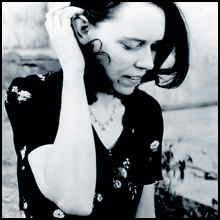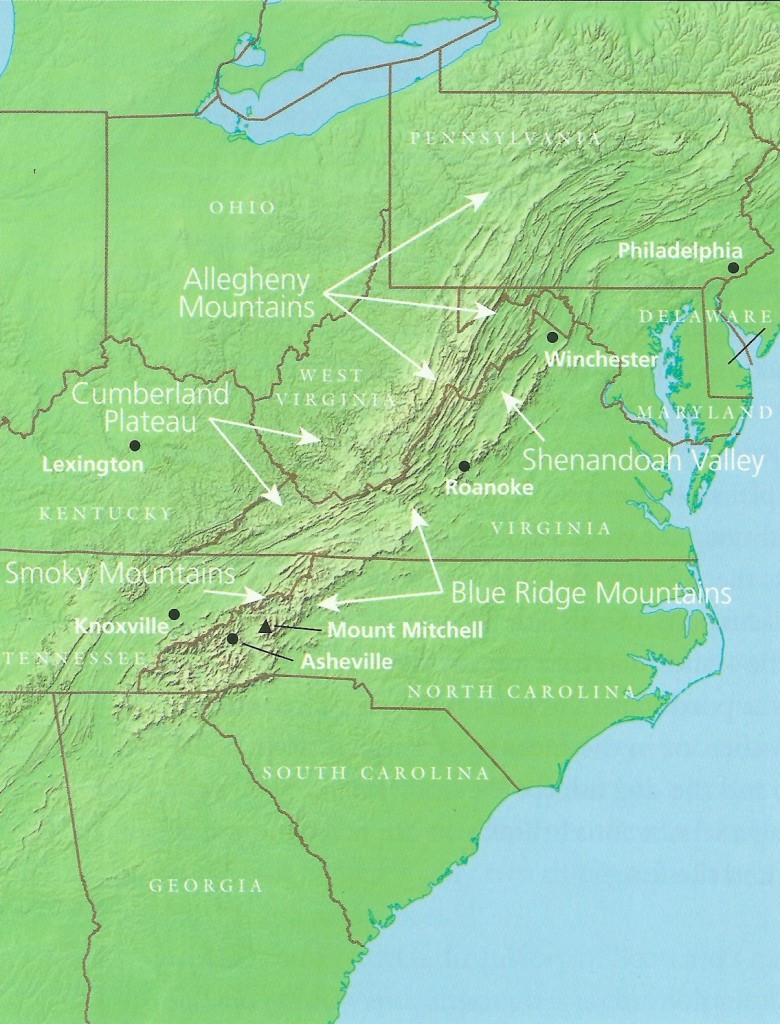
For reference: Great Wagon Road (Wikipedia). Great Appalachian Valley
Appalachian Music (Wikipedia)
Assigned listening:
“Three Little Babes”, a British ballad sung by Texas Gladden. LYRICS. Recorded by Alan Lomax in Salem, Virginia: 1959. In the oldest mountain vocal styles, the singer sings alone and unaccompanied, often with eyes closed or avoiding eye contact. Appalachian vocalists prefer a strident, nasalized vocal timbre — the “high lonesome sound“ — and their singing is forthright and uninhibited. Gladden sings a ballad on the theme of excessive grief keeping the dead from finding a permanent resting place. British versions of this ballad are usually known under the title “The Wife of Usher’s Well” (Child 79). The melody here uses only six tones (an authentic pentatonic mode with the octave repeated) and remains within the range of an octave. Gladden recorded numerous ballads for the Library of Congress in the 1930s and 1940s. At the time of this recording, she was neither in the best of health or voice. Source: Southern Journey: Ballads and Breakdowns, Vol. 2. Alan Lomax Collection. Rounder CD 1702, 1997.
See versions of “The Wife of Usher’s Well” as collected by Cecil Sharp.
“Little Margaret,” Sheila Kay Adams (Madison County, North Carolina, 1982). Recorded by Alan Lomax. A contemporary Appalachian version of Child Ballad #74 known in the British Isles as “Lady Margaret and Sweet William.” Adams sings a version of the ballad similar to variant “C” in this collection of song texts.
“Little Margaret,” Rhiannon Giddens with Francesco Turrisi (2019).
“Bonaparte’s Retreat,” Gaither Carlton. Recorded by Ralph Rinzler in Deep Gap, North Carolina: 1963. One of numerous tunes which commemorate Napoleon Bonaparte. Carlton offers a traditional rendition in a 4/4 meter. Two of the fiddle’s strings produce drones suggestive of bagpipes accompanying the advancing and retreating army regiments. With Doc Watson on guitar.
The fiddle, perhaps the most common and typical folk instrument of the Southern Appalachians, was introduced by the mid-to-late eighteenth century as settlers of the Southern Appalachian region made their way down the Valley of Virginia. Played at dances, with and without vocal accompaniment, by Anglo-Celtic and African American musicians, the fiddle’s intense tones complement the mountain vocal style. The first British colonies were established in America about the time that the fiddle reached its peak of popularity in Great Britain, where it had gradually replaced the bagpipes, except in isolated parts of the Gaelic world. The fiddler, with a tune bag of Irish jigs, Scotch reels, and English hornpipes, provided the dance music for pioneer and frontier America. Source: The Watson Family (Folkways, 1963) .
“Silver Dagger” Dolly Parton (1999) LYRICS Read about this American ballad.
African American Banjo Styles
“Coo Coo” John Snipes of Orange County, North Carolina. Recorded in 1974 by Cecelia Conway. In the late twentieth century, many elderly Black and white banjo players in the Southern Appalachian region still played this complex, haunting piece in an old “clawhammer” style. The banjo, believed to have been introduced into the mountains in the early to mid-nineteenth century directly and indirectly from African American sources became a staple of Appalachia string band music.
“Going Where I’ve Never Been Before” John Snipes. This song is a sequence of emotional core lines about a lover moving on. Each line is repeated once and the stanzas are improvisationally varied. The form suggests the banjo’s influence on the composition of the earliest recorded blues, which repeated formulaic, familiar lines.
“Roustabout” Dink Roberts, clawhammer banjo and vocals. Along with “Coo Coo,” this is an important showpiece tune in the African American banjo repertory.
Source for these Black banjo style songs: Black Banjo Songsters of North Carolina and Virginia (Smithsonian Folkways CD 40079, 1998). For reference, African Banjo Echoes in Appalachia by Cecelia Conway (Knoxville: Univ. of TN Press, 1995)
“Cornbread and Butterbeans” (2008). Carolina Chocolate Drops. LYRICS. Contemporary black string band performers, featuring Rhiannon Giddens
Appalachian Sampler
“Country Blues,”Recorded by Dock Boggs, New York: 1927. LYRICS.
“Country Blues” is an American folk song better known by the title “Darling Corey.” “Dock” Boggs (1898-1971) was from Norton, a coal mining town in the Virginia panhandle. Boggs, a white musician, was influenced by the African-American music in his region and his banjo playing and singing has a bluesy feel. After recording for Brunswick Record in the 1920s, Boggs had hoped a music career might help him avoid the mines. However, he worked as a miner most of his life, retiring in 1952. He was rediscovered in the 1960s by Mike Seeger and played various folk festivals, including the 1963 Newport Folk Festival and the 1969 Festival of American Folklife. Source: Smithsonian Folkways/Anthology of American Folk Music.
“June Apple” Charlie Higgins (fiddle), Wade Ward (banjo), and Bob Carpenter (guitar). Dance music recorded by Alan Lomax in Hillsville, Virginia: 1959. This vigorous breakdown is played by 81-year-old Higgins. The banjo’s ability to produce percussive, nasal tones and emulate the melodic slides of the fiddle well-suited it for mountain music. The fiddle-banjo duet became a preferred ensemble by the latter part of the nineteenth century. (Musicological note: this tune is characterized by whole-step harmonic alternations between the sub-tonic [G] and tonic scale degrees [A] in a heptatonic mixolydian mode.)
“Soldier’s Joy” Fiddle band dance tune recorded by Gid Tanner and His Skillet Lickers. Atlanta: 1929. Columbia Records. Tanner, fiddle; Clayton McMichen, fiddle, spoken interjections; Riley Pucket, vocal, guitar; Fate Norris, banjo. “Soldier’s Joy” is a well known fiddle piece with origins in eighteenth-century Britain. This popular north Georgia band, whose name typified the self-parody often favored by hillbilly bands, played with a twangy, wild abandon. The two fiddlers featured here represented strongly contrasting musical impulses: Tanner was a rural, undisciplined hoedown fiddler, while McMichen was a more controlled and eclectic player with a liking for pop music and jazz. They were backed by Riley Puckett, a blind musician from Alpharetta (Georgia), whose rapid multiple guitar runs were a distinguishing feature of Skillet Lickers recordings.
The guitar, which was known in the Southern Appalachians before the mid-nineteenth century, only became integrated into mountain music in the early part of the twentieth century in the wake of availability via Rural Free Delivery from catalog stores such as Sears Roebuck and Montgomery Ward and its use by commercial country stars such as Jimmie Rodgers and the Carter Family in the 1920s.
“Lazy Farmer Boy” Buster Carter and Preston Young. LYRICS. American ballad performed by this string band duo from Virginia (vocals and fiddle). Recorded in 1930. Source: Smithsonian Folkways/Anthology of American Folk Music.
See the version transcribed by Cecil Sharp in Tennessee in 1916.
“The Boy Who Wouldn’t Hoe His Corn” Alison Krauss and Union Station. April 2002 at the Louisville Palace in Louisville, Kentucky. Vocal by Dan Tyminski. Fiddle and harmony vocal by Alison Krauss. Contemporary bluegrass version of the American ballad.
“West Virginia Gals” Al Hopkins and His Buckle Busters (1928). LYRICS Originating in antebellum minstrelsy, this song became an indictment, couched in humor and stereotype, of backwoods mountaineers.
“Wreck of the Old 97” Recorded by Vernon Dalhart (1924). Read about the wreck and the ballad’s history. LYRICS
A song from the Depression years: “How Can a Poor Man Stand Such Times and Live?” LYRICS. performed by Blind Alfred Reed (vocal and fiddle). 1929. Reed (1880-1956) born in Floyd, Virginia, was one of the artists who recorded at the Bristol (Tenessee) Sessions in 1927, alongside more famous names such as Jimmie Rodgers and The Carter Family.
Anti-gun ballad written and sung by Steve Earle, “The Devil’s Right Hand” (1988). LYRICS
Roseanne Cash sings “The Parting Glass” (2017). From the album Big Bend Killing: The Appalachian Ballad Tradition (Topic). LYRICS Read about this traditional Scottish song.
“Decoration Day” Ballad written and performed by Jason Isbell, with the Drive-By Truckers. (2003) LYRICS
The Carter Family:
“John Hardy Was a Desperate Little Man,” American ballad, possibly of African-American origin, recorded by the Carter Family in Camden, New Jersey, 1928. LYRICS.
Sara Carter, vocal and autoharp; Maybelle Carter, guitar. The Carter Family band from Maces Spring, Virginia, consisted of A.P. Carter (1891-1960), Maybelle (1909-1978) and Sara (1898-1979). One of the most important groups in American musical history, the Carter Family, with various family members, was active for over seventy years. In early August 1927, Victor talent scout Ralph Peer advertised in a Bristol, Tennessee, newspaper for local musicians to audition. These “Bristol Sessions” were responsible for the discovery of the Carters and Jimmie Rodgers (The Singing Brakeman), the two most important recording artists in early country music. A.P. Carter and Leslie Riddle collected traditional songs from the Southern Appalachian region near their home and arranged them in the Carter Family’s style. A.P. Carter was one of the first musicians to copyright such traditional arrangements in his own name and prepare song folios for sale. The Carters’ music was a sacred and secular mixture. Many of their songs have become country and bluegrass standards and have influenced countless musicians.
Most of the original Carter Family’s lead vocals were done by Sara. Maybelle played guitar and autoharp. During their career they recorded over three hundred songs including such standards as “Wildwood Flower”, “Jimmie Brown the Newsboy,” and “Keep on the Sunnyside.” . The Carters continued to record through the Depression, before they stopped performing as a group in the early 1940s.
The Carter Family went across the Texas-Mexico border in 1938 to broadcast on radio stations XERA, XEG, and XENT. These Border radio (“X” stations) eluded Federal Communicaitons Commission limitations on the power of their transmissions. They broadcast performers’ music far and wide in the US and included the return of the “medicine show” to the airwaves– alternating music and comedy with sales pitches for patent medicines and dubious medical procedures.
Maybelle Carter played guitar in a distinct style, picking out the melody on the bass strings. It is a style that she learned from an African-American neighbor, Leslie Riddle. “Mother Mabelle”‘s picking influenced many guitarists and is a strongly identified with the folk revival. She and Sara made appearances at folk festivals during the 1960s including Newport and the Smithsonian Festival of American Folklife.
The next generation of the Carter Family saw a group made up of Maybelle along with June, Helen, Anita, and Jeanette. The younger women starting performing with A.P., Sara and Maybelle during their border radio period. The later Carter Family was also a top selling recording group during the 1960s and 1970s. The extended Carter Family included June’s husband Johnny Cash and daughter Roseanne who continues to perform and record.
“Single Girl, Married Girl,”American ballad, recorded in Bristol, Tennessee: August 2, 1927. LYRICS Sara Carter, vocal and autoharp; Maybelle Carter, guitar. “Single Girl” is one of the six songs recorded for Ralph Peer during their initial session. Source: Smithsonian Folkways/Anthology of American Folk Music
“Can the Circle Be Unbroken (Bye and Bye)” Country gospel song performed by the Carter Family. New York: 1935. Read about this song. Maybelle Carter, vocal, guitar; Sara Carter, vocal, autoharp; A. P. Carter, vocal. A classic recorded by many musicians in many styles over the years.
“Postcard” First Aid Kit (2018) LYRICS Swedish sister duo Klara and Johanna Söderberg, influenced in their songwriting and harmonies by Carter Family, Emmylou Harris, Louvin Brothers.
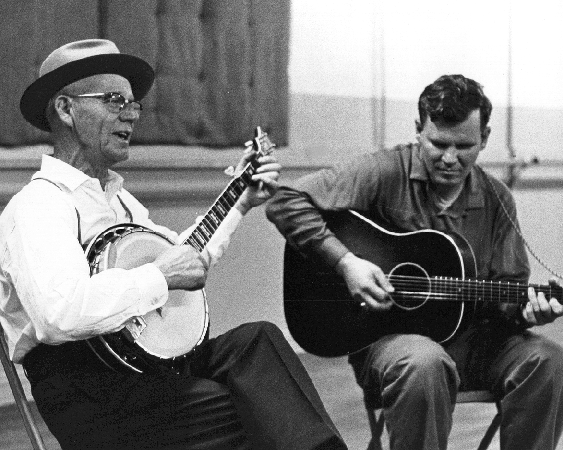
Tom Ashley—Old Time Appalachian Musician
Raised by his mother and grandparents in Mountain City, Tennessee, Clarence Tom Ashley (1895-1967) learned to sing and to play the banjo under the tutelage of his music loving family.
“House Carpenter” Clarence Tom Ashley, vocal and banjo. Recorded in Atlanta, 1930. LYRICS.
“House Carpenter” is an example of a British Ballad (Child 243) kept alive in America. (Alternate titles: “The Daemon Lover”; James Harris) . Source: Smithsonian Folkways/Anthology of American Folk Music
In his early career Clarence Ashley traveled with medicine shows. During the 1920s and 1930s he acted as front man in many of the groups he played with, mixing humor with music. Ashley recorded on several labels and with various old time string bands. After his initial recording career ended, he made a living sawmilling and farming, supplementing his income by what he called “busting” (busking — passing the hat for money as he played). By the mid-1940s, Ashley had stopped playing banjo after suffering a work-related accident to his hand. Folklorist and musician Ralph Rinzler, one of the many younger musicians influenced by Harry Smith‘s Anthology of American Folk Music, ran into Ashley in North Carolina at the 1960 Union Grove Fiddler’s Convention. Rinzler remembered Ashley from the Anthology and asked if he could record him. He encouraged Ashley to resume his banjo playing. This subsequent recording session also brought the brilliant guitarist Arthel “Doc” Watson to the attention of Rinzler. One of the major talent scouts for the Newport Folk Festival, Rinzler saw to it that Ashley and Watson were presented to folk revival audiences via appearances at festivals and nightclubs. Ashley influenced artists such as the New Lost City Ramblers, Bob Dylan, the Grateful Dead, and the Red Clay Ramblers.
Southern Appalachian Murder Ballads:
“Ommie Wise” G.B. Grayson, vocal and fiddle. Recorded in Atlanta, 1927. LYRICS to Doc Watson version.
Source: Smithsonian Folkways/Anthology of American Folk Music. Grayson (1888-1930) was a blind fiddler from East Tennessee. Most of his significant recordings were done with his partner Henry Whitter (1892-1941). Whitter was one of the first country musicians to play guitar with a harmonica rack around his neck, an image later identified with Woody Guthrie and Bob Dylan.
Grayson and Whitter, “Rose Conley” (1927) Likely derived from an Irish ballad. See “Down in the Willow Garden”. Other versions. LYRICS.
Grayson and Whitter’s recordings were big sellers for the Victor Talking Machine Company. In 1930, the duo was the first group to record “Tom Dooley”, the North Carolina murder ballad popularized in the1950s by the Kingston Trio. The Sheriff Grayson who arrests Tom Dooley in the song was G.B. Grayson’s grand uncle.
“The Banks of the Ohio” Blue Sky Boys. LYRICS. Earl Bolick (1919-1998), lead vocal and guitar; Bill Bolick (1917-2008), tenor vocal and mandolin. Recorded in Charlotte, North Carolina in 1936. This American ballad has been frequently recorded. The Blue Sky Boys from western North Carolina were models for many of the brother harmony teams in country music who learned from their records of traditional songs. Their slower, more sentimental style contrasts with that of the Monroe Brothers, who emphasized challenging high harmonies and aggressive speeds. Source: Anthology of American Folk Music, Vol. 4 (Austin, Texas: Revenant, 2000)
“Poor Ellen Smith,” Molly O’Day & The Cumberland Mountain Folks, 1949. Evidence of the hard driving sound that would become a major feature of bluegrass is present in O’Day’s treatment of this old American ballad. LYRICS Lois LaVerne Williamson (b.1923 in McVeigh Kentucky; d. 1987), better known as Molly O’Day, was a widely admired female country singer of the 1940s. Source: Columbia Country Classics: The Golden Age. Another version of “Poor Ellen Smith” by Wilma Lee Cooper.
“Tom Dooley,” Grayson and Whitter’s 1929 recording for Victor Records, Memphis, Tennessee.
“Tom Dooley” performed by the folk revival group Kingston Trio (1958).
Twenty-five-year-old Thomas C. Dula was hanged on May 1868 for the murder of Laura Foster in Wilkes County, NC. Before the Civil War, Tom had been lovers with both Laura and her cousin Ann Foster. After returning home from the war, he took up again with Laura. Ann, meanwhile, had maried James Melton. In May 1866 Tom suggested eloping, and Laura was not seen again. A posse found Dula in Tennessee and brought him back a prisoner. Dula and Ann Melton were tried for murder (by some accounts, he had contracted a veneral disease from Laura and passed it on to Ann). Dula was found guilty; he appealed, was retried, and found guilty a second time. Ann Melton was acquitted after two years in jail waiting for trial, but according to local legend she confessed on her deathbed. Source: Folk Song America: A 20th Century Revival, (Washington, D. C.: Smithsonian Collection of Recordings, 1990) More on “Tom Dooley.”
“Pretty Polly” Estil C. Ball, vocal and guitar. Recorded by Alan Lomax in Rugby, Virginia, 1959. LYRICS Source: Southern Journey: Voices from the American South, Vol. 1 (Rounder CD 1701, 1997) Read about this American ballad that had its beginnings in Britain.
“Caleb Meyer” Revising the Appalachian murder ballad. Written and performed by Gillian Welch accompanied by David Rawlings. (1998). LYRICS.
John Henry
Featuring an African American protagonist, “John Henry” is among the most important and widely-known American ballads. Whether there existed a historical John Henry remains a matter of debate among folklorists and historians. The John Henry legend grew in oral tradition. Folklorist Richard Spotswood has written that “John Henry’s martydom symbolized the tension between manual labor and the industrial revolution, from which, at least for many, there was no redemption. His steam drill has come to symbolize worker obsolescence through every new industrial refinement from the cotton gin to computer-driven factories.”
Ballads about John Henry’s life typically contain four major components: a premonition by John Henry as a child that steel-driving would lead to his death, the lead-up to and the results of the legendary race against the steam hammer, Henry’s death and burial, and the reaction of his wife.–Wikipedia
Some Versions of “John Henry”:
“John Henry” Ed Lewis, vocals and axe strokes, 1959. Work song. Recorded by Alan Lomax at Camp B, Mississippi State Penitentiary, Lambert, Mississippi.
“John Henry Blues” Evans & McClain, 1927? Joe Evans was born in the early 1900s in Knoxville (TN) where he spent most of his career as a musician and later as a boot black. His repertoire covered earlier string music as well as the contemporary blues of the period. Nothing is known of Arthur McClain. Source: Before the Blues, Vol. 3 (Yazoo 2017: 1996)
“Gonna Die With My Hammer In My Hand” The Williamson Brothers and Curry, 1927. The Williamson Brothers came from Logan County, West Virginia, not far from John Henry’s legendary Big Bend Tunnel, built between 1870 and 1872 by the C & O Railroad. Source: Smithsonian Folkways/Anthology of American Folk Music.
“Spike Driver Blues” guitar and vocal by Mississippi John Hurt. LYRICS. 1928. “This is the hammer that killed John Henry, but it won’t kill me.”
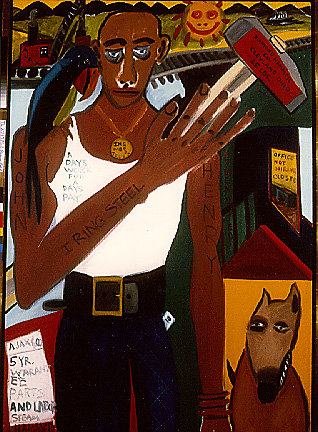
Painting by Frederick Brown (ca 1977).National Museum of American Art, Washington, D. C.
Examples of Occupational Ballad — Coal Mining Song:
“Sixteen Tons” written and sung by Merle Travis. (Originally released in 1947.) Read about “Sixteen Tons.”
“Coal Miner’s Daughter” Written and performed by Loretta Lynn. Nashville. (1969. Decca.) LYRICS. Loretta Lynn came from a coal mining famiy and was the second of eight children. Her first hit, “Honky Tonk Girl” (1960) on Zero Records of Vancouver, Canada, took Lynn to Nashville. She became a regular on the Wilburn Brothers television show and continued to write and record many songs: “Success,” “Blue Kentucky Girl.” But it wasn’t until her recordings of “You Ain’t Woman Enough” and “Don’t Come Home A Drinkin'” that Lynn’s mucis took a new direction. Instead of using traditional country music themes, she wrote songs that were more realistic and less compromising. In a familiar pattern, her outspoken songs such as “Fist City” and “The Pill” used humor to address highly-charged issues of sexual roles. “The Pill” Loretta Lynn. Nashville, 1972 (MCA Records). LYRICS. Written by Lynn.
“Clay County Miner” written and sung by Hazel Dickens. (1974?) LYRICS
“Black Lung” American ballad written by Hazel Dickens. Sung by Kathy Mattea (2007). LYRICS. What is black lung disease?
Sarah Ogan Gunning sings her composition “Come All You Coal Miners.” LYRICS.
Leaving Appalachia:
Steve Earle, “Hillbilly Highway” (1986). LYRICS
Some Varieties of Religious Song in Appalachia
“Down in the Valley to Pray,” a camp meeting spiritual dating from the early nineteenth century. Doc Watson, Ricky Skaggs, Earl Scruggs, Alison Krauss. (2010?)
Read the history of the camp meeting.
“Camp a Little While in the Wilderness,” (1992) early nineteenth century camp meeting spiritual sung by Sheila Kay Adams.
“Guide Me O Thou Great Jehovah” Hymn sung by Ike Caudill and congregation in “lining out” style. Recorded by Alan Lomax, September 6, 1959 at the Mt. Olivet Old Regular Baptist Church, Blackey, Kentucky. Old Regular Baptists sing “lining hymns,” a style that grew directly out of the Protestant Reformation. Church reformers sought to involve church members directly in the service by doing away with choirs and letting everyone raise their voice to sing God’s praises. Most church-goers of the time could not read and frequently had no secular models to follow for group singing. One solution was for the congregation to repeat each line of a hymn after a leader, with each individual singer following the melody according to his or her own inspiration.
Guide me, O thou great Jehovah,
Pilgrim through this foreign land.
I am weak, but Thou art mighty,
Hold me with Thy powerful hand.
Bread of heaven, bread of heaven,
Feed me, till I want no more.
Source: Southern Journey: Voices from the American South, Vol.1. Alan Lomax Collection. (Rounder CD 1701, 1997).
What is “shape-note” and “Sacred Harp” singing?
Read and listen: Jesse Karlsberg and Steve Bransford, “‘Within Thy Circling Pow’r I Stand’: Immersive Video from within Sacred Harp’s Hollow Square” (2020)
“Rocky Road” Performed by Alabama Sacred Harp Singers. Recorded in Atlanta, April 16, 1928. Source:Smithsonian Folkways/Anthology of American Folk Music. LYRICS.
This style of “shape-note” singing, which relies both upon printed song books and oral tradition, originated in New England in the eighteenth century and spread extensively below the Mason-Dixon Line by the mid-nineteenth century. Sacred Harp singing is a non-denominational community musical event emphasizing participation, not performance. Singers sit facing inward in a hollow square. Each individual is invited to take a turn “leading,” i.e. standing in the center, selecting a song, and beating time with the hand. The singing is not accompanied by musical instruments. The group sings from The Sacred Harp, an oblong songbook first published in 1844 by B.F. White and E. J. King. The repertory includes psalm tunes, fuging tunes, odes and anthems by the first American composers (1770-1810), and also settings of folk songs and revival hymns (1810-1860). The current 1991 edition contains many songs in these styles by living composers.
“The Last Words of Copernicus” Sung by the Alabama Sacred Harp Singers. Recorded by Alan Lomax, September 12, 1959 in Fyffe, Alabama. Lomax had recorded Sacred Harp singing in 1942, and a handful of commercial recordings made of small groups of singers attempting to recreate something of the Sacred Harp’s unique beauty had also been made. The recording technology of the time, however, simply could not capture the extraordinary polyphony of shape-note singing. Armed with sensitive ribbon microphones and the first portable stereo recorder, Lomax was able to approximate the Sacred Harp style on tape. Source: Southern Journey: Voices from the American South. The Alan Lomax Collection, Vol. 1 (Rounder Records, CD 1701, 1997). LYRICS
Sacred Harp has deep roots in the Protestant churches of England and Scotland, where the democratic ideals of the Reformation held that everyone should have a voice in church. The style was first developed in eighteenth century New England as a way to teach the small congregation lacking instruments and trained singers to function as a choir. Hymns were written out with bass, treble, and soprano parts (alto parts were added in the nineteenth century) and singers learned melodies from shaped note texts. When fully realized, the results are stunning. Typically, singers will begin by singing the tune’s melody using the fa, sol, la, and mi syllables of the scale to fix the tune, following it with the actual text of the hymn.The bass, tenor, treble, and alto parts are relative and not fixed to a pre-determined pitch.
Sacred Harp singing faded in New England as greater prosperity enabled churches to buy organs and establish full-time choirs. The style spread south with the Great Awakening and camp meetings of the early nineteenth century, finding favor among Baptists and Methodists. A separate black Sacred Harp tradition also developed. The style of singing flourished in the South partly because of the proscription of musical instruments in some Baptist denominations, but mainly because Sacred Harp meetings or “singings” (which are not actual church services) attracted hundreds of singers and constituted a vital form of fellowship among the small, scattered country homesteads and churches in the era before paved roads and telephones. Today, Sacred Harp singing remains a robust tradition and a unique experience. The singing is filled with the exuberance and passion of its participants and has moved back into the Northeast, other locales in the US, and into Britain and Europe.
Bluegrass:
“Blue Moon of Kentucky” Bill Monroe and His Blue Grass Boys. (1946.) LYRICS. Source: The Best of Bill Monroe (MCA 1999)
“I’m Working on a Building” Bluegrass gospel song performed by Bill Monroe and His Blue Grass Boys. (1954.) LYRICS. Source: The Best of Bill Monroe (MCA 1999)
Biographical sketch of Monroe.
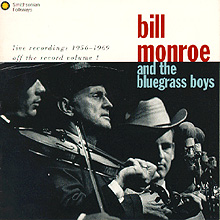
The mandolin, which like the guitar, had been available by mail order through the Sears Roebuck catalog since the early 1900s, rose to importance with the advent of bluegrass in the 1940s. Its prominence was in large part due to the virtuoso playing of the “father of bluegrass.” Bill Monroe was born into a musical family in Rosine, Kentucky, in 1911. It was an area where the state’s rolling hills teemed with verdant grass known as the bluegrass region, a term Monroe would borrow to name his music. He took up the mandolin as a child and began playing with his uncle Pendleton Vandiver, an accomplished fiddler. In the early 1930s, Bill team with his brother Charlie to play old-time music as The Monroe Brothers. When they split in 1938, Bill determined to forge a new style using his distinctive high tenor voice and mastery of the mandolin as starting points. “I was going to put the high, lonesome sound in it,” he later recalled, “the hard drive to it, and play the melody where it would have a feeling in it.” With his new group, which became known as the Blue Grass Boys, Monroe made his Grand Ole Opry debut in 1939.
Key developments occurred in Monroe’s music with the addition of Lester Flatt and Earl Scruggs to the Blue Grass Boys in December 1945. Flatt played a solid rhythm guitar style that would help to set the course for bluegrass timing. Scruggs played the banjo with a distinctive three-finger picking style that immediately caused a sensation among Opry audiences. Flatt and Scruggs joined a highly accomplished group that included fiddler Howdy Forrester and bassist Joe Forrester and would soon include fiddler Chubby Wise and bassist Howard Watts. In retrospect, this lineup of the Blue Grass Boys has been dubbed the “Original Bluegrass Band”, as the music finally included all the elements that characterize bluegrass music, including breakneck tempos, sophisticated vocal harmony arrangements, and impressive instrumental proficiency demonstrated in solos or “breaks” on the mandolin, banjo, and fiddle.[–wikipedia ]
“Randy Lynn Rag” Lester Flatt and Earl Scruggs with the Foggy Mountain Boys. Originally recorded in 1955 in Nashville for Columbia Records. In 1948 Lester Flatt and Earl Scruggs left Bill Monroe to form the Foggy Mountain Boys, who performed in mountain hamlets, regional circuits, and major city venues such as Carnegie Hall. Scruggs, from Flint Hill, North Carolina, wrought a revolution in banjo playing when he popularized his three-finger method in the twenty years after 1945.
Three traditional Appalachian songs performed in the early 1960s by Ralph and Carter Stanley (1927-2016) : “Man of Constant Sorrow“ LYRICS, “Oh Death” (LYRICS), and “Rank Stranger” LYRICS
Bob Dylan’s version of “Man of Constant Sorrow” (1962)
Berzilla Wallin sings “Conversation with Death.” Recorded in 1963 by Peter Gott and John Cohen in Big Laurel, North Carolina.
“Dixieland” Steve Earle and the Del McCoury Band (1999). LYRICS Source: The Mountain (E-Squared, 1999). Biography of Earle. Biography of Del McCoury.
Southern Appalachian Links of Interest:
WMMT Mountain Community Radio streaming live from Whitesburg, Kentucky.
Appalachia (Wikipedia).
Sweet Is the Day: A Sacred Harp Family Portrait (Streaming video 59:34). This documentary film tells the story of the Woottens, one of the key singing families who have helped Sacred Harp music survive and flourish for more than 150 years.
